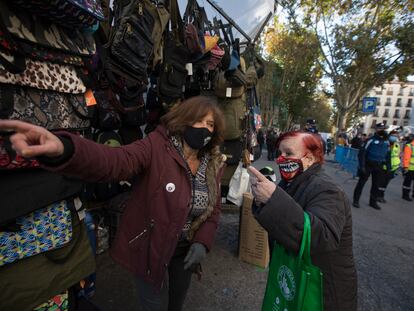New coronavirus cases fall by half in two weeks, but deaths remain high
According to the latest Health Ministry report, the 14-day cumulative number of infections in Spain has dropped below 400 for the first time since October 23
In just two weeks, new coronavirus cases reported by Spain’s regions have gone from 52,386 to 25,886. This is the Monday figure from the central Health Ministry for this week and the last, and covers three days – Friday, Saturday and Sunday – given that the government does not release data about the epidemic over the weekend. In total, 1,582,616 infections have been confirmed in the country since the start of the health crisis, but in terms of the 14-day cumulative number of coronavirus cases per 100,000 inhabitants, a key indicator for the progress of the coronavirus, there is better news. The parameter has fallen from 460.26 to 374.52 in a week, a drop of 20% and a level that has not been seen since October 23.
Fernando Simón, the director of the Health Ministry’s Coordination Center for Health Alerts (CCAES) and the visible face of the government during the pandemic, recognized the improvement on Monday, but warned that “it is not known” whether the trend will continue, or “if it will rise again as in other weeks,” in reference to the start of October, which saw a spike after several days of stability.
The Health Ministry added 512 deaths to the official toll, which now stands at 43,131
The bad news continues to be the number of Covid-related fatalities. Monday’s report added 512 to the overall death toll, a figure last seen on Monday, November 9. In terms of fatalities over the last seven days, the figure is holding steady, at 1,878 in Monday’s report, compared to 1,908 on November 16. The confirmed number of coronavirus victims in Spain now stands at 43,131, although the real number is likely much higher given that many people died with the coronavirus in the first wave before they could be tested.
Simón pointed to the fact that the number of deaths “is the last indicator to fall” when the overall incidence is going down, given that it is the last stage in the process of infection, hospitalization, intensive care unit (ICU) treatment and fatality (if indeed that process takes place – fortunately fewer than 1% of cases are fatal).
The gradual fall in new infections is slowly starting to be seen in the number of hospital admissions. Yesterday’s report saw a total of 17,695 patients, compared to 17,936 reported on Friday. This means that 14.26% of Spanish hospital beds are occupied by Covid patients. This continues to be high, and only the Canary and Balearic islands, Extremadura and Galicia are below 10%. A week ago, however, the figure was 16.54%. The fall – 12% in seven days – is slower than that of new infections.
ICU numbers have also improved, falling to 29.98% compared to 32.80% a week ago. La Rioja continues to be in a serious situation, with 58% of ICU beds occupied by coronavirus patients. The upper limit for this indicator is considered to be 35%, a threshold currently exceeded by the following territories: Aragón and Asturias (47%), Castilla y León (44%), Catalonia (38%), Ceuta (41%) and Melilla (43%).
Simón has also indicated that it is normal for the number of tests to fall in line with the number of diagnoses. Between November 13 and 19, there were 1,027,987, of which 30% were antigen tests. The positivity rate – i.e. the percentage of tests coming back positive – has fallen to 11%. On November 16 there were 1,155,018 tests, 28% of which were antigen, with a positivity rate of 12.7%.
English version by Simon Hunter.
Tu suscripción se está usando en otro dispositivo
¿Quieres añadir otro usuario a tu suscripción?
Si continúas leyendo en este dispositivo, no se podrá leer en el otro.
FlechaTu suscripción se está usando en otro dispositivo y solo puedes acceder a EL PAÍS desde un dispositivo a la vez.
Si quieres compartir tu cuenta, cambia tu suscripción a la modalidad Premium, así podrás añadir otro usuario. Cada uno accederá con su propia cuenta de email, lo que os permitirá personalizar vuestra experiencia en EL PAÍS.
¿Tienes una suscripción de empresa? Accede aquí para contratar más cuentas.
En el caso de no saber quién está usando tu cuenta, te recomendamos cambiar tu contraseña aquí.
Si decides continuar compartiendo tu cuenta, este mensaje se mostrará en tu dispositivo y en el de la otra persona que está usando tu cuenta de forma indefinida, afectando a tu experiencia de lectura. Puedes consultar aquí los términos y condiciones de la suscripción digital.
More information
Últimas noticias
Israel sparks a civil war within the MAGA movement
The complicated life of Francesca Albanese: A rising figure in Italy but barred from every bank by Trump’s sanctions
Reinhard Genzel, Nobel laureate in physics: ‘One-minute videos will never give you the truth’
Pinochet’s victims grapple with José Antonio Kast’s rise in Chile
Most viewed
- Reinhard Genzel, Nobel laureate in physics: ‘One-minute videos will never give you the truth’
- Pablo Escobar’s hippos: A serious environmental problem, 40 years on
- Charles Dubouloz, mountaineering star, retires at 36 with a farewell tour inspired by Walter Bonatti
- Why we lost the habit of sleeping in two segments and how that changed our sense of time
- The Florida Keys tourist paradise is besieged by immigration agents: ‘We’ve never seen anything like this’










































